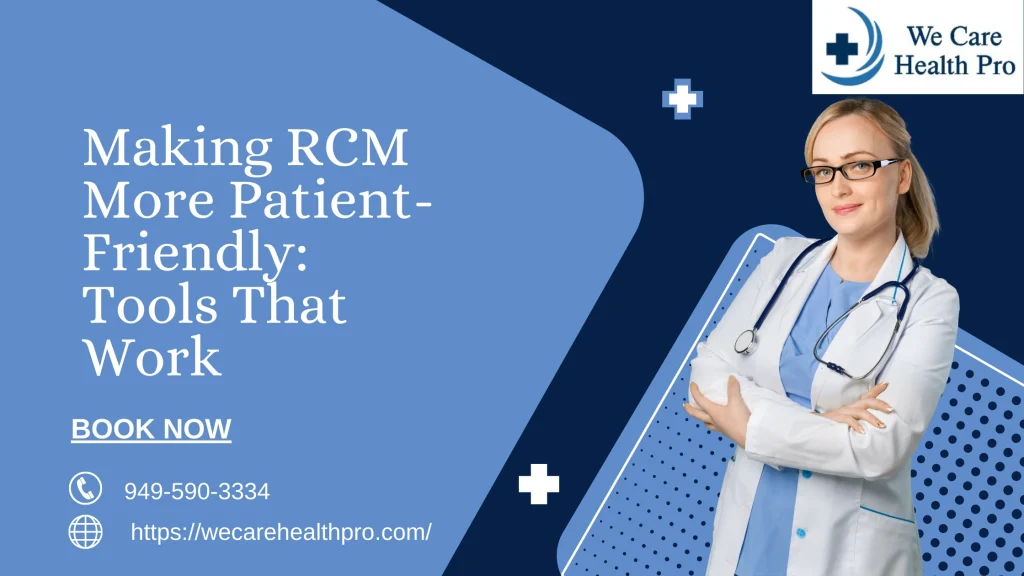Patient-friendly RCM tools : Let’s face it—healthcare billing can be puzzling. Patients frequently sense lost in codes, claims, and unexpected prices. That’s in which Revenue Cycle Management (RCM) comes in. But right here’s the trap: traditional RCM systems are constructed for providers, no longer patients. It’s time to alternate that.
In this weblog, we’ll discover how to make RCM greater affected person-friendly. We’ll look at gear that simplify billing, improve communication, and help patients sense greater on top of things of their healthcare price range.
Why Patient-Friendly RCM Matters
RCM is the procedure that handles the whole lot from scheduling and coverage verification to billing and collections. It’s the monetary backbone of healthcare.But when patients don’t understand their bills—or feel overwhelmed by payment processes—it leads to frustration, delayed payments, and even lost trust.
Making RCM more patient-friendly isn’t just good for patients. It’s good for providers, too. Happier patients pay faster, ask fewer questions, and are more likely to return.
Tools That Make a Real Difference
Dig deeper into the gear that have a vast effect. These are not just elegant terms for generation, but genuine, realistic methods that facilitate billing and improve affected person management.
1. Clear, Digital Statements
Paper bills are old. They’re tough to study, clean to lose, and frequently difficult. Digital statements, on the other hand, are clean, interactive, and accessible anytime.
- Patients can view charges line by line
- They can click to see explanations for each item
- They can pay instantly through secure links
This simple shift reduces confusion and speeds up payments.
2. Patient Portals with Billing Access
Most healthcare systems already use patient portals.But many don’t include billing functions. That’s a neglected opportunity.
When sufferers can log in and spot their balance, coverage information, and fee history, they sense extra on top of things. Add functions like live chat or support, and you’ve got a powerful tool for engagement.
3. Automated Payment Plans– patient-friendly RCM tools
Not everyone can pay a big medical bill all at once. Offering flexible payment plans—particularly those that patients can set up—is a sport-changer.
Tools like automatic installment options or “pay later” buttons assist patients control charges with out calling billing departments. It’s handy, respectful, and effective.
4. Upfront Cost Estimates
One of the biggest frustrations in healthcare is not knowing what something will cost. Patients often get hit with surprise bills weeks after a visit.
RCM tools that offer real-time cost estimates before treatment help solve this. They pull data from insurance providers and past billing to give patients an idea of what they’ll owe. It builds trust and reduces sticker shock.
5. Mobile-Friendly Payment Options
Let’s be honest—most people no longer sit at desktops to pay bills. They do it on their phones, between meetings, or while waiting in line.
RCM systems that offer mobile-friendly payment options—like Apple Pay, Google Pay, or even text-to-pay—make it easier for patients to take action. The simpler it is, the faster they’ll pay.
6. AI-Powered Chatbots for Billing Questions– patient-friendly RCM tools
Patients have questions. Lots of them. And they don’t always want to wait on hold.
AI chatbots make billing easier by giving patients quick answers to common questions. They can break down charges, explain insurance terms, and walk users through how to make a payment—all in real time. And since they’re available 24/7, patients get help whenever they need it.
The best part? They don’t replace your team—they support it. While chatbots take care of the everyday questions, your team gets more time to focus on the meaningful, one-on-one conversations that truly make a difference for patients.

7. Multilingual Support
In a diverse united states of america like the U.S., language topics. Offering billing tools in multiple languages facilitates sufferers experience visible and understood.
Whether it’s Spanish, Mandarin, Arabic, or Hindi, multilingual guide improves readability and decreases mistakes. It’s a easy way to expose admire and enhance service.
How to Start Making RCM More Patient-Friendly
No need to revamp the whole thing right now. Begin with a couple of tools that match your workflow, then step by step make bigger as you see what works exceptional for your group and sufferers.
Begin with digital statements and cellular bills
Add value estimates and charge plans as you grow
Train team of workers to use those equipment and provide an explanation for them to sufferers
The intention is to make billing sense less like a burden and greater like a conversation.
At the end of the day, healthcare is about people. Yes, RCM is a technical process. But it touches every patient who walks through your doors.
By using tools that simplify, clarify, and empower, you’re not just improving your revenue—you’re improving relationships. And that’s what keeps patients coming back.
Final Thought: RCM doesn’t have to be cold and complicated. With the right tools, it can be clear, kind, and helpful. Let’s make billing part of the healing process—not a hurdle.
Would you like help choosing the best RCM tools for your practice or writing patient-friendly billing guides? I’m here to help you make healthcare feel more human.

